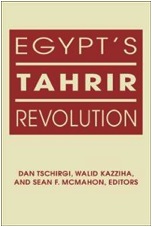
Egypt’s Tahrir Square Revolution edited by Dan Tschirgi, et al. Published by Lynne Rienner Publishers, London and Boulder, Colorado. 2013, 287 pages.
This is an interesting book analytically, simply because the twelve contributors to the volume are academics at the American University of Cairo, and in the introduction they have the intellectual courage to admit that the events of 2011, now called the Arab Spring caught them unprepared. It is this introduction that drew me to the volume, and specifically an assessment in hindsight of why these professors steeped in the politics, culture, and events of Egypt were unable to detect the changes among the country’s body politic. Have all the institutions of the former regime of Hosni Mubarak been expunged, re-invented, or undermined? To some Egyptians this was a revolution, to others this was incomplete and some of the political pillars of the old regime remain. What are the new political relationships forming between secularists, the Muslim Brotherhood, the Army, the ancient Coptic Christians, and the Salafis of various stripes? These twelve academics attempt to answer these questions.
The introduction authored by the editors argues that the Supreme Council of the Armed Forces (SCAF), the entity that existed between the fall of Mubarak and the election of the Islamist Mohammad Morsi, bowed to the pressure of politics. This took the form, first of the SCAF taking into consideration popular protests and international opinion by allowing Morsi to assume the presidency, and then working with Morsi to retire the Defense Minster Field Marshal Mohammed Tantawi and his service chiefs. But not all is as its seems, for member of the SCAF still remain in active duty, and those retired were given lucrative civilian posts befitting their stature, for example, the former Navy Chief, Admiral Mohab Mamish now directs the Suez Canal Authority. The book outlines the three political blocs that has formed in the aftermath of the revolution, the Islamic bloc, the liberal bloc, and the SCAF bloc. Pages then delve into the schisms within each bloc as the inevitable human process of political compromise takes hold.
The chapter by Mustafa Kamal al-Sayyid looks at education, demographics, and the impacts of economic liberalization initiated by Sadat and continued with Mubarak that led to his downfall. You will learn how trade unions became more outspoken and even aggressive as the gaps between rich and poor widened. Mubarak, according to the chapter, was caught between transitioning from economic liberalization to democratization or suppress civil society and political organization? Walid Kazziha, looks into the family business of Mubarak Inc., and the means of guaranteeing Mubarak and his entourage took the form of an ever increasing reliance on the security apparatus. The anatomy of mass protests in Tahrir Square 2011, is of great interest, since the security apparatus was not only overwhelmed by numbers, but also overwhelmed by the use of technology to organize flash mobs and mass demonstrations.
Sherine El-Ghatit poses an excellent scoratic question to open her chapter, Revolution without Islamists.” In it she, asks whether the Tahrir Revolution of 2011 was a initially a revolt without Islamists? She concludes with her analysis that this was not a revolution without Islamists but neither was it an Islamist revolution. Today the Youth Coalition of the Revolution has been sidelined in Egypt, leading to protests. Labor movements who taught Egyptians to find the courage to face the regime before Tahrir Square have been barred from forming a political party, based on a law that prohibits the forming of political parties based on class affiliations. El-Ghatit exquisitely discusses the interactions between various Islamists, liberals, and workers as Egypt attempts to find a modicum of stability. In the meantime grievances and demonstrations continue on the streets of Cairo, Alexandria, Suez and other major cities in Egypt.
